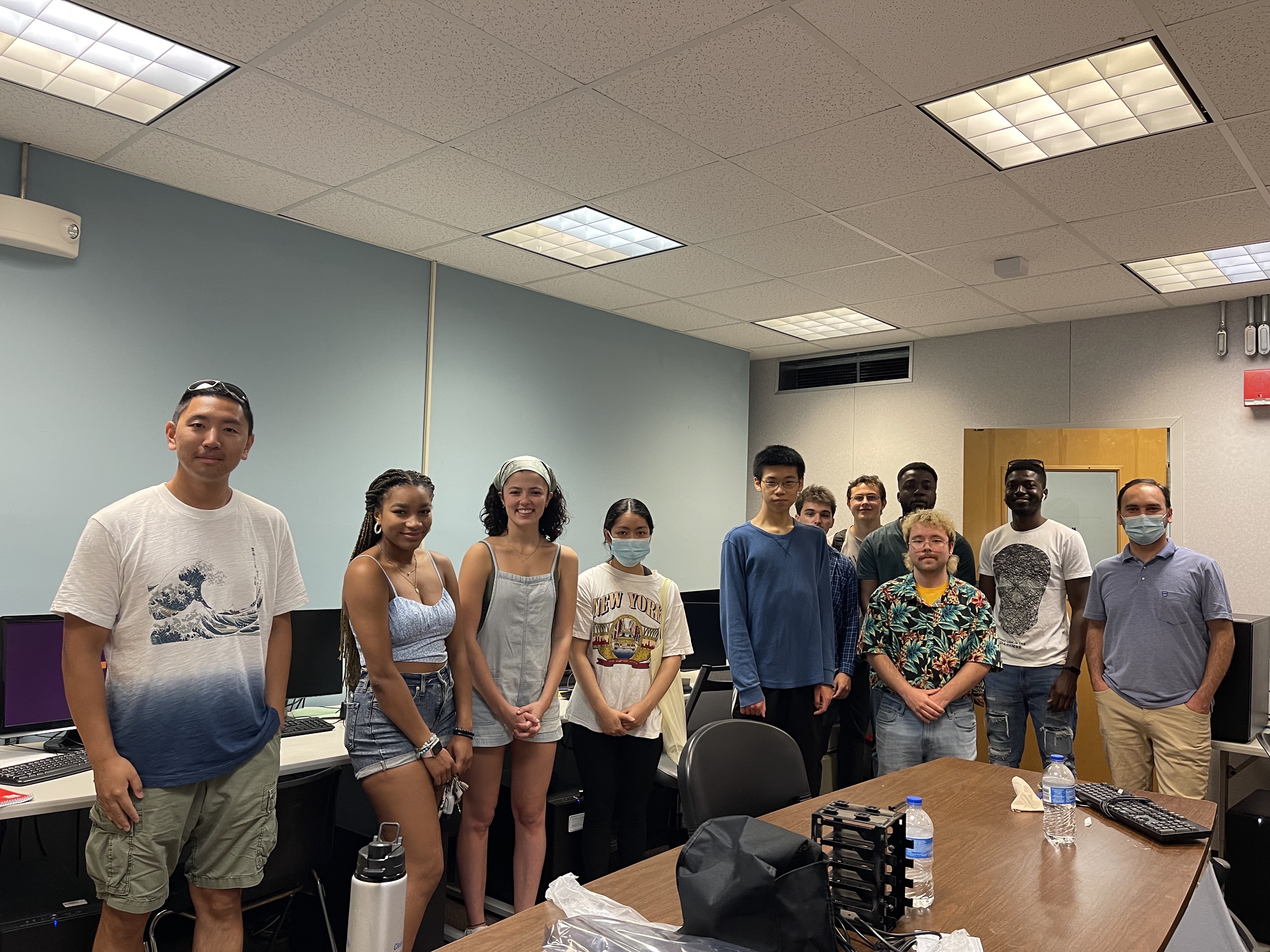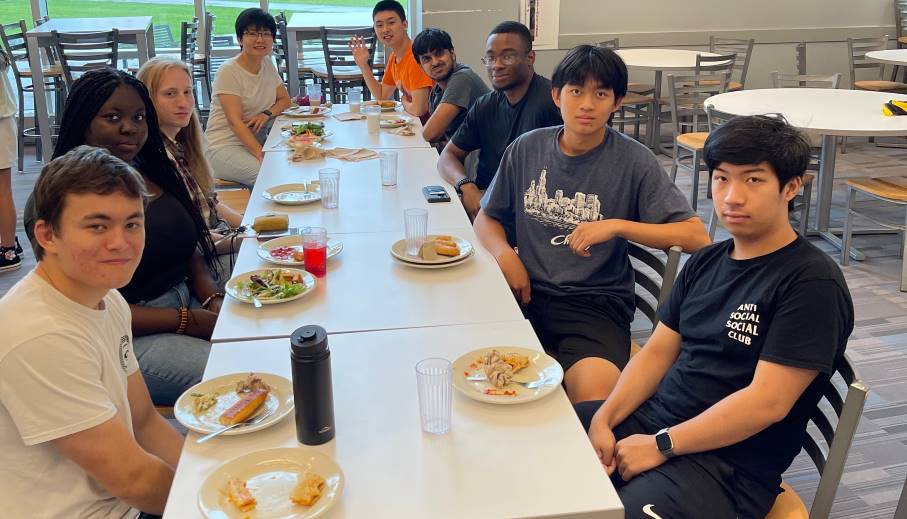Activities and Campus Visit (Participants and Mentors)
 |
 |
|---|---|
 |
|
Group Meeting and Project Presentation
 |
 |
|---|---|
 |
|
Student Publications
- Alan Okinaka, Gulfam Saju, and Yuchou Chang. "Enhancing Image Reconstruction via Phase-Constrained Data in an Iterative Process." In International Symposium on Visual Computing, pp. 406-414. Cham: Springer Nature Switzerland, 2023.
- Alan Okinaka, Gulfam Saju, and Yuchou Chang. "Automating Kernel Size Selection in MRI Reconstruction via a Transparent and Interpretable Search Approach." In International Symposium on Visual Computing, pp. 420-430. Cham: Springer Nature Switzerland, 2023
- Gulfam Saju, Alan Okinaka, and Yuchou Chang. "Exploiting Generative Adversarial Networks in Joint Sensitivity Encoding for Enhanced MRI Reconstruction." In International Symposium on Visual Computing, pp. 443-451. Cham: Springer Nature Switzerland, 2023.
- Jacob Morosco and Yuchou Chang, "Visual Inference Using Homology of Human and Machine Vision Systems," the 10th Annual Conference on Advances in Cognitive Systems (ACS), Arlington VA, November 19-22, 2022.
- Chetan Kumar, James Patrick Donohue, Rohan Gonjari, Neela Rahimi, John McLinden, Yalda Shahriari, and Ming Shao, "Adversary on Multimodal BCI-based Classification," the 11th International IEEE EMBS Conference on Neural Engineering, Baltimore, MD, April 25-27, 2023.
- Priscila Silva, Mariana Hermosillo Hidalgo, Igor Linkov and Lance Fiondella, "Predictive Resilience Modeling," in Proceedings of the Resilience Week, September 26-29, 2022.
- James Lu, Todd Morehouse, Jiawei Yuan, and Ruolin Zhou. "Machine-Learning PUF-based Detection of RF Anomalies in a Cluttered RF Environment." In 2021 IEEE International Symposium on Technologies for Homeland Security (HST), pp. 1-7. IEEE, 2021.
- Julio Galvan, Ashok Raja, Yanyan Li, and Jiawei Yuan. "Sensor Data-Driven UAV Anomaly Detection using Deep Learning Approach." In MILCOM 2021-2021 IEEE Military Communications Conference (MILCOM), pp. 589-594. IEEE.
- Marc Tunnell, Huijin Chung, and Yuchou Chang, “A Novel Convolutional Neural Network for Emotion Recognition Using Neurophysiological Signals.” In IEEE International Conference on Robotics and Automation 2022 (ICRA).
**REU students are highlighted in bold fonts
Projects Information of Program 2021
| Student | Mentor | Project Title | Project Description |
|---|---|---|---|
| Andrew Anctil | Dr. Ming Shao | Enabling Automatic Continual Learning | The project “Enabling Automatic Continual Learning” proposes an interesting framework to enable the evolution of machine learning models in a robust and sustainable manner. This project first explores state of the art continual and lifelong learning algorithms. A novel model with the ability to automatically choose the appropriate continual learning methods is then developed to maintain the learning accuracy in the long run. |
| Leeban Ali, and Devin M Foxhoven | Dr. Gokhan Kul | Software Performance Estimation through Continuous Code Monitoring |
The project “Software Performance Estimation through Continuous Code Monitoring” explores effective ways of monitoring code and its performance changes, a key step to secure the reliability of software. This project develops a code monitoring tool that plugs into the Continuous Integration process. It estimates the performance impact of incoming code changes by evaluating programmer habits, programming language structures used and operations to be performed. |
| Morgan Britt-Webb | Dr. Ming Shao | Adversarial Learning on Multimodal Brain Signal Recognition. |
The project “Adversarial Learning on Multimodal Brain Signal Recognition” explores the how adversarial machine learning affects multimodal brain signal processing. This has been a concern in cybersecurity where sensitive clinical data may be contaminated. This project investigates electroencephalography (EEG) and functional near-infrared spectroscopy (fNIRS) brain signal imaging techniques and machine learning algorithms on the recognition of patients with Amyotrophic Lateral Sclerosis (ALS). Adversarial attack algorithms are applied to EEG, fNIRS and their fusion to motivate novel defense mechanisms and improve the robustness of brain signal machine learning models. |
| Huijin Chung | Dr. Yuchou Chang | EEG-Based Emotion Recognition using Transfer Learning and Brain-Visual Representations | The project “Software Performance Estimation through Continuous Code Monitoring” explores effective ways of monitoring code and its performance changes, a key step to secure the reliability of software. This project develops a code monitoring tool that plugs into the Continuous Integration process. It estimates the performance impact of incoming code changes by evaluating programmer habits, programming language structures used and operations to be performed. |
| Julio Galvan | Dr. Jiawei Yuan | UAV Anomaly Detection using Deep Learning Approach |
The project “UAV Anomaly Detection using Deep Learning Approach” investigates how to leverage IMU sensor data and a deep learning approach to detect the abnormal status of UAVs. By developing a new convolutional neural network, we demonstrate the effectiveness of our approach with simulation results. The is of great real-world and research value as it provides a self-collected sensor data-driven UAV anomaly detection dataset as well as an effective deep learning model. |
Mariana Hermosillo Hidalgo |
Dr. Lance Fiondella | Resilience Modeling: A Quantitative Approach | The project “Resilience Modeling: A Quantitative Approach” explores different metrics to quantify the resilience of systems over time. In particular, this project develops quantitative resilience models to characterize performance degradation and recovery. The models enable prediction and the calculation of resilience metrics from the literature. |
| Jin Feng Lin | Dr. Ruolin Zhou | Optimization of CNN model | The project “Optimization of CNN model” explores lightweight CNN models developed on FPGA. Compared to the CPU and GPUs, Field-Programmable Gate Array (FPGA) delivers superior performance in deep learning applications where low latency is critical. The project focus on developing a lightweight FPGA-based CNN architecture for RF signal detection and classification. |
| James Lu | Dr. Ruolin Zhou and Dr. Jiawei Yuan | Machine-Learning PUF-based Detection of RF Anomalies in a Cluttered RF Environment | The project “Machine-Learning PUF-based Detection of RF Anomalies in a Cluttered RF Environment” explores deep learning in detection of malicious devices. It is expanding the robustness of SDR using CNN to detect potentially malicious devices sending signals to transmitters. This concept is then applied to airplane ADS-B radar signals to reinforce their security. |
Marc Tunnell |
Dr. Yuchou Chang | A Novel Convolutional Neural Network for Emotion Recognition Using Neurophysiological Signals | The project “A Novel Convolutional Neural Network for Emotion Recognition Using Neurophysiological Signals” proposes a novel deep infrastructure to improve EEG-BCI classification accuracy. This study proposes the use of Thomson Multitaper PSD estimation in the EEG-BCI classification pipeline as well as a novel architecture based on regularized separable convolutions, designed to efficiently make use of the PSD extracted features. Further, the project evaluates the efficacy of interspersed Gaussian noise as a data augmentation technique and investigates abnormalities in the convergence of widely used optimizers as applied to 'difficult' data. |
Projects Information of Program 2022 |
|||
Jacob Morosco, |
Dr. Yuchou Chang | An Inference Study Using the Microsoft COCO Dataset for Semantic AI |
The objective of the project is to explore the inferences that can be drawn from large-scale visual recognition datasets, e.g., the MS COCO dataset. To achieve this, a visual graph of the inferences will be created using an Inference Engine written in Java. By running the dataset through the engine, it will identify the concepts in the dataset that are interrelated and uncover "inferences" from the dataset. The engine will generate a Knowledge Graph, which can be visualized using GraphViz tools, facilitating a comprehensive understanding of the visual concepts and deep analysis of new inference information. |
Ashlee Shuemaker, |
Dr. Lance Fiondella | Agent-based Modeling and Simulation of Nonviolent Action | There is an increase in the use of misinformation and disinformation, particularly through social media, which causes internal strife on various issues. The project employed an agent-based model to identify relationships between social media blackouts, and the rate of information dissemination within these conditions. In addition to providing valuable insight into information dissemination, the agent model also proves useful in identifying protest participation, whether that be violent or nonviolent, and identifying how manipulating parameters of the simulation manifest themselves as trends within the protest participation. |
Grace Elena Stewart |
Dr. Gokhan Kul | VulBERT: Backdoor Vulnerability Detection by Feeding Hard-coded Credentials to Bidirectional Encoder Representations from Transformers | The project aims to explore and address the fundamental issues in security that hard-coded credentials can be used as backdoors into a software developer's code, allowing hackers and other attackers to gain unapproved administrative access or access to restricted data. This research project investigates the feasibility of applying the state-of-the-art transformer-based language model BERT to detect hard-coded credentials in software. |
Alexandre Broggi |
Dr. Gokhan Kul | Applying Open Set Algorithms to Machine Learning-based Network Intrusion Detection | The project aims to detect novel attacks, a critical challenge for current Network Intrusion Detection Systems (NIDS). To that end, three open-set recognition techniques in machine learning have been explored in an attempt to identify related classes with valuable uncertainty measurements. The project has investigated open-set uncertainty with images that the model was not trained for as a feasibility study. The methodology was then extended CIC-IDS2017, a NIDS dataset for further demonstration. |
James Patrick Donohue |
Dr. Ming Shao | Adversarial Attacks on Multimodal Graph Neural Networks | The project was the first attempt to apply adversarial attack to brain signals models constructed through graph neural network (GNN). Graph perturbations, namely node injection and edge manipulation are observed in wholesale to determine their effectiveness on the following modalities: electroencephalography (EEG), event-related potential (ERP), and functional near-infrared spectroscopy (fNIRS), brain signal imaging techniques used on patients with Amyotrophic Lateral Sclerosis (ALS). Adversarial attack algorithms are applied to EEG, ERPs, and fNIRS to motivate novel defense mechanisms and improve the robustness of brain signal machine learning models. |
Kevin Chen |
Dr. Jiawei Yuan | Privacy-Preserving Machine Learning as A Service | Security and privacy have been a major concern in AI, and machine learning in particular recently. The project applied recent advancements in cryptography, such as fully homomorphic encryption to enable user privacy for machine learning in the cloud. Multiple security models and techniques have been considered. The performance and security of such models are also compared. |
Theresa Ng |
Dr. Ruolin Zhou | Mimicking GPS Signals | GPS signals are weak broadcasted signals and have become affected by in-band interference. GPS spoofers can generate a GPS signal to mislead a GPS receiver through software-defined radio (SDR). The project explores ways of mimicking GPS signals, a fundamental security issue in signal processing. In particular, the project investigates two SDRs, namely, ADALM-PLUTO and USRP X-300. These two radios will transmit a GPS signal to spoof a smartphone. The receiver antenna calculated a GPS location based on the GPS signal transmitted by the phone. The phone was only able to calculate a location when the USRP X-300 transmitted the signal. |
Projects Information of Program 2023 |
|||
Andrew J Bajumpaa |
Dr. Lance Fiondella | Application of Point Set Registration and De-noising to 3-D Robotic Bio-printing | Bio-printing via an autonomous system could vastly simplify the treatment of certain wounds within a medical setting. This project, "Application of Point Set Registration and Denoising to 3-D Robotic Bio-printing," uses a depth scanning camera to produce a 3-D model to enable bio-printing. A single-lens system would have more difficulty self-correcting its motion during a procedure. This project aims to develop de-noising and registration algorithms, enabling the construction of accurate models despite inaccurate sensor data. Visualization and surface reconstruction tools have also been developed to enable trust computing. |
Alan Okinaka |
Dr.Yuchou Chang | Transfer Learning Assisted Parameter Selection for Water-fat Separation in Dixon MRI | The Dixon method is a clinical magnetic resonance imaging (MRI) approach employed to differentiate and separate water and fat signals. The efficiency of the Dixon method is largely influenced by the optimal selection of parameters such as Echo Time (TE) and Echo Spacing. However, acquiring these optimal parameters can be challenging due to the limited availability of training datasets and the complexity of manual selection. This project, termed "Transfer Learning Assisted Parameter Selection for Water-fat Separation in Dixon MRI," proposes a novel parameter selection method using transfer learning on simulated images to address these challenges. Experimental results reveal that these pre-trained models can successfully classify the simulated images, thereby providing promising implications for enhancing the performance of the Dixon method in MRI. |
Aditya Bala and Kevin Zhang |
Dr. Yuchou Chang | Clinical Diagnosis of Alzheimer's Using EEG Analysis | Alzheimer's Disease (AD) is a serious type of decline in brain functions that affects memory, thinking, and behavior. This project, titled "Clinical Diagnosis of Alzheimer's Disease with EEG Analysis," will focus on electroencephalogram (EEG) scans for identification of Alzheimer's Disease and its biomarkers. It focuses on the development of a Python program that utilizes EEG data to check for possible signs of Alzheimer's Disease. The program uses Linear Discriminant Analysis to provide transparent results for physicians in clinical settings. Python sample codes from MNE-Python and a database of 88 patients on OpenNeuro are used to build and train machine learning models. |
Charles Li |
Dr. Ruolin Zhou | Exploring and Understanding Drone Wireless Communication Through Software Defined Radio | Software Defined Radio (SDR) is a versatile communication technology that utilizes an embedded system to send and receive radio frequency signals. The project "Exploring and Understanding Drone Wireless Communication through Software Defined Radio" uses software GNU Radio Companion and radio transceiver HackRFOne to transmit and receive RF signals. The generated RF signals are then applied to investigate the wireless communication of drones to better understand their vulnerabilities and methods for defending. Furthermore, this project explores the vulnerabilities of drone video and controller systems and investigates whether these aspects of drones can be spoofed. |
Kelly Zeng and |
Dr. Lance Fiondella | Predictive Modeling for Investment Decision-Making Using Finance System Engineering: A Study on the S&P 500 | The project "Predictive Modeling for Investment Decision Making Using Finance System Engineering: A Study on the S&P 500" aims to leverage Finance System Engineering principles to develop a predictive modeling framework for investment decision-making. Preprocessed data is used to train a machine learning model to predict future movements of the S&P 500 index. Algorithms, including random forests, support vector machines, and deep learning architectures, are considered and evaluated for their predictive performance. The research findings can provide valuable insights for investors, financial institutions, and asset management firms, facilitating more informed and data-driven investment strategies. |
Nathan Xu |
Dr. Ming Shao | An Empirical Study of the Robustness of LLMs through LLaMA.cpp | The project "An Empirical Study of the Robustness of LLMs through LLaMA.cpp" aims to explore LLMs specifically designed to be built and deployed across different systems. Large Language Models (LLMs) leverage large amounts of data to train text-generative models. This project uses LLaMA.cpp, a C++ ported version of Llama that can run on regular PC for extensive evaluations. The project has made great strides in understanding the needs and capabilities of LLaMA.cpp by investigating its robustness and security, as well as making comparisons with popular commercial LLMs, such as ChatGPT. |
Ryan Berry |
Dr. Gokhan Kul | Using Natural Language Processing to Improve the Classification of Unknowns by Network Intrusion Detection Systems | Network Intrusion Detection Systems (NIDS) are an important part of network defense because they monitor network traffic in real-time to detect threats. The project "Using Natural Language Processing to Improve the Classification of Unknowns by Network Intrusion Detection Systems" aims to develop novel open-set machine learning algorithms to address the unknown malicious or benign activities for NIDS. In addition, Natural Language Processing (NLP) models are leveraged to encode patterns and semantics in the header and payload information to enable real-time analysis. |
Tiye Ngachoko |
Dr. Gokhan Kul | Code Pattern Recognition for Instructions Captured from CPU Instruction Cache | The objective of the project "Code Pattern Recognition for Instructions Captured from CPU Instruction Cache" is to investigate codes being executed on the CPU and determine if they are malicious. It is expected that all instructions sent to the CPU will be evaluated for malicious activity in real time. High-level languages like C/C++ and Java are very expressive, and the coders can easily hide malicious activity using advanced coding practices. The project explores how the code to be executed is transferred into the instruction cache, in addition to its functionalities on commodity CPUs, and moves to different possible tactics for capturing instructions in the cache or sent to the CPU, followed by anomaly detection. |

